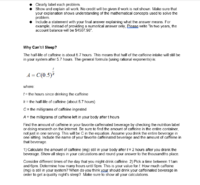enuff4u2nv1
New member
- Joined
- Jun 29, 2020
- Messages
- 7
Why does it matter if it's "a decimal"? Are you calculating it with paper and pencil? Why not just use the exponent button on your calculator?I was trying to plug in the numbers to the equation given but the denominator in the exponent is a decimal. So I really dont even know where to start
You should have shown what you did, so we can see where you are stuck. What you presumably did is the way to start!I was trying to plug in the numbers to the equation given but the denominator in the exponent is a decimal. So I really dont even know where to start
First thing you need to do is to
Simply multiply the numerator and denominator of the exponent by 10 and wave goodbye to the decimal in the denominator.I was trying to plug in the numbers to the equation given but the denominator in the exponent is a decimal. So I really dont even know where to start
Now you just type that expression, [MATH]57(0.5)^{2/5.7}[/MATH], into your calculator. What kind of calculator do you have?unsure of what to do next
scientificNow you just type that expression, [MATH]57(0.5)^{2/5.7}[/MATH], into your calculator. What kind of calculator do you have?
Typically, you'll type in something like "57 * 0.5 ^ ( 3 / 5.7)" or "[MATH]57 \times 0.5\; x^y\; (3\div 5.7)[/MATH]".
Well a lot depends on your calculator. On my calculator, I would probably clear memory, calculate 2/5.7 and store that in memory. Then I would enter 0.5 and then x^y, hit recall from memory, and multiply the result by 57. If your calculator has parentheses, you could also use them to organize the order of operations. Hit 57, multiply, ( 0.5, x^y, ( 2, divide, 5.7))scientific
should that 3 be a 2?
in regards to the actual steps to solve, would I do the exponent 1st? (.5)^(2/5.7)
I have to show this step by step. I can't just provide the answer. That is why I'm trying to get an understanding for how to actually work the equation.
There are quite different kinds of scientific calculators; you may need to either tell us the make and model, or at least describe it fully. For example, some display only a number, while others show what you have entered, which may be on a line or formatted as in a book. Each of these requires different keystroke sequences.scientific
in regards to the actual steps to solve, would I do the exponent 1st? (.5)^(2/5.7)
I have to show this step by step. I can't just provide the answer. That is why I'm trying to get an understanding for how to actually work the equation.
There are quite different kinds of scientific calculators; you may need to either tell us the make and model, or at least describe it fully. For example, some display only a number, while others show what you have entered, which may be on a line or formatted as in a book. Each of these requires different keystroke sequences.
But for any kind, you need to use whatever mechanism it provides to evaluate the exponent before applying it.
Also, do you have an example of how you are expected to show steps? It may require less than you think.

Thank you Dr. PetersonI would say that "show all work" means to show the equation you write and the main steps to solve it, including the expression you evaluate to get the final answer. You wouldn't need to show each individual operation you carry out.
The Windows calculator, in Scientific mode, is the type where you generally enter a number followed by the operation you need to do (e.g. press the square root button after entering the radicand); but for this expression, you will enter it more or less as written, apart from needing parentheses around the exponent. As I said before, "57 × 0.5 xy (2 ÷ 5.7)" .
